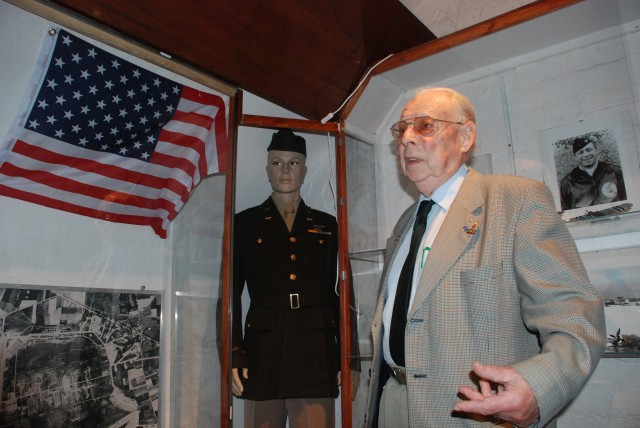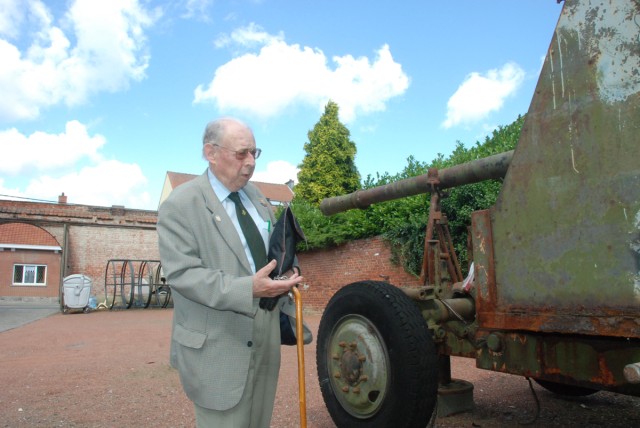CHIAfE+VRES, Belgium Aca,!" Little else but homes with cropped roofs just outside of ChiAfA..vres Air Base betray the peaceful farming community that this Belgian area has become through the years.
In this town where cows now graze was once a prime location during World War II for occupying German forces to establish a military base with a simple airfield, halfway between Berlin and London. The interrupted rooflines adjacent to ChiAfA..vres Air Base's control tower once ensured ample room for heavily-loaded German bombers to gain altitude when launching bombing raids against Allied forces.
In this town where expansive sugar beet fields are harvested today was once where 30 German aircraft launched their bombing campaign against Normandy's landing beaches during the monumental battle June 14, 1944. Allied forces returned volley a few months later after wresting control of the air base Sept. 3, launching bombing raids against German positions in the Ardennes during the Battle of the Bulge in December.
In this town where inconspicuous evidence of the war more than 65 years later includes a quaint six-year-old museum chronicling the air base's history, a 13-year-old boy once helplessly sheltered himself in a muddy ditch while German anti-aircraft artillery retaliated against heavy Allied bombing.
Now, the curator of the idiosyncratic museum, AndrAfA Neve calmly remembers lying in that ditch and the peculiar, raw smell of smoke from bomb fragmentation mixed with earth.
"I started hearing the bombs explode like thunder, and to a young boy it felt much closer than they actually were," he reminisced with tranquil detachment through an English translator.
"I felt I should take cover in a ditch nearby. I don't believe I was particularly afraid. It was just the way of life during the war for our towns. I was used to the bombs at that point in the war, so I wasn't particularly scared at first. My family had already been evacuated to northern France just before the Battle of Dunkirk, so we experienced a war zone before. It was the same when we returned," he continued.
Though the Allied bombing campaign devastated military targets on the base, collateral damage took a heavy toll on the townspeople. After more than 30 raids, 26 civilians perished, an additional 34 locals suffered severe wounds and 41 houses were razed.
As a boy, Neve lived in Lessines, a town near ChiAfA..vres. He would frequently ride his bike 20 minutes through the nearby towns to visit a family friend living in ChiAfA..vres. He would often peak through the air base's fence while passing by for a glimpse of the daily operations.
Neve said life was difficult during German occupation from 1940-44. Besides living under the war's constant threat to his personal safety, Neve often wanted to rebel against the restrictions in place, during this time, such as paltry food rations and tight 9 p.m. to 6 a.m. nightly curfews. He was also deeply disturbed by the deaths of two friends, killed by Allied bombs in Flanders. As a way to work through his adolescent emotions, he would chronicle significant events happening before his eyes. In later years, he would come to trace the starting point of his life-long interest in the town's history to these diaries.
"Even at that age, I knew something important was happening," he said. "I wrote down facts about the war in a journal - but only facts, never personal feelings. It was a way to deal with my emotions during a very turbulent time."
The German air force drew its labor force from local villages, with more than 9,000 townspeople constructing hangars, runways, barracks, ammunition depots, bomb shelters, radar and anti-aircraft positions. For several years on a daily basis, trains filled to capacity brought thousands of workers, including electricians, builders, road workers and masons. At the base's zenith of German control in 1942, 7,000 troops and nearly 300 bombers were stationed there.
German troops surrounded the airfield with a net of anti-aircraft batteries, commonly referred to as flak. To detect and pinpoint enemy airplanes, the Germans also set up three powerful radar posts, including a Freya radar system at Lens in 1942 to detect distant airplanes.
One U.S. aircraft shot down by these German batteries was the B-17 Royal Flush, returning from a mission over Schweinfurt in Germany April 13, 1944. Four of the crew members were able to bail out prior to the Royal Flush hitting the ground and exploding in the Belgian town of Silly.
Local townsman Ghislain Bonnet was 15 years old at the time and still remembers that sunny spring afternoon in 1944.
"I remember seeing one of the aviators who got injured when getting to the ground," he recalled. "The Belgian resistance fighters were first on the spot, and three of the survivors evaded capture thanks to their help. Unfortunately, they were not able to rescue this injured aviator as the Germans rapidly arrived on the scene.
"I also remember receiving a chocolate bar from this wounded aviator. I found out later that his name was Charlie Johnson and that he survived the war," he added.
In late August, shortly before abandoning the air base in retreat, German forces annihilated the base's infrastructure and burned more than 27 tons of base records. U.S. Army engineers began rebuilding the air base within a week of U.S. troops liberating ChiAfA..vres, becoming operational again by October.
Neve recalled the days after the town's liberation as a jubilant time. His father was the first Belgian employee hired by the U.S. forces and supervised construction workers, including German prisoners of war. Neve, who would later become an NCO in a Belgian armored division, was 17 at the time and assisted his father with administrative tasks, expanding his knowledge of the air base.
For the remainder of the war, the base was used by U.S. and British forces to launch air support for missions, including the Allied crossing of the Rhine River during Operation Plunder and a vaunted campaign in the Ardennes that proved to the biggest and bloodiest battle Americans fought.
The Battle of the Bulge, which lasted from Dec. 16, 1944, to Jan. 25, 1945, was the largest land battle involving American forces of World War II. More than a million Allied troops fought in the battle across the Ardennes, including approximately 500,000 Americans and 55,000 British. More than 19,000 American troops were killed in action.
"The air base has historical importance to the world," Neve said. "Prior to the war, ChiAfA..vres was just a small village. Nobody from outside of the area would have ever heard of it.
"I was always interested in the history of ChiAfA..vres and the air base," he explained. "Living through it, I wanted to capture that history and pass it on to future generations. We're not here forever... Starting the museum while there are still witnesses, ensures that knowledge will be passed on."
The museum, shaped to replicate the inside of a U.S. Fairchield C-119 Flying Boxcar, covers the history of the air base starting from 1918 until present.
"It's a powerful museum," said Clancy Hammond, U.S. Army Benelux Directorate of Logistics chief. "I feel honored to serve here knowing the great sacrifices our nations have made on behalf of our freedom."
Neve aims to expand the museum to include more information while the air base's mission evolves and new material becomes available, he said, "as history is in perpetual movement.
"The work we do here today bridges the air base from the past into the future, so the sacrifices made here are never forgotten," he said.
"For tomorrow, today will belong to history."




Social Sharing